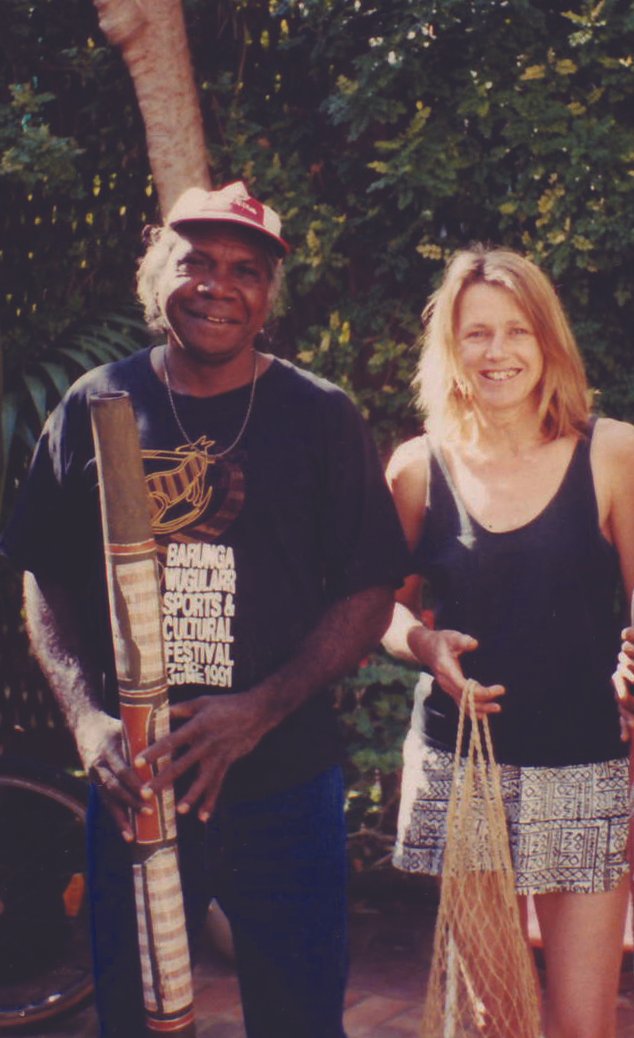PADDY FORDHAM WAINBURRANGA
BIOGRAPHY

(1941 - 2006)
During his lifetime, renowned artist, dancer, didgeridoo player and storyteller, Paddy Fordham Wainburranga embodied the living history of the people of Australia’s far north. Born in the bush at Bumdubu, near Bulman, north east of Katherine, Paddy lived a totally traditional life, learning the ancient customs and Dreamtime stories from his father and uncles. He first encountered whites at the age of eleven when, with European settlement encroaching on their lands, the Rembarrnga people were settled at Maningrida.
Paddy began working as a stockman as a young man on many of the stations throughout the Top End and it was not until the 1970’s when, settled once more at Maningrida, Paddy began to paint for the nascent Arts and Crafts Centre. Having learnt traditional bark painting from his father and being steeped in ancient stories, his innovative talent for formulating narrative sequences in a manner both authentic and accessible won him quick recognition. In time he became the senior elder of the Rembarrnga people and divided his time between making artworks and leading the Rembarrnga in important ceremonial activities throughout the Northern Territory.
After leaving Maningrida and setting up his outstation further south near Bulman, Paddy Fordham was instrumental in helping to establish Mimi Arts and Crafts in Katherine, and later created many of his finest paintings and sculptures while working with Aboriginal entrepreneur Glen Bird who encouraged him to concentrate on major thematic works. The finest of these were exhibited at Coo-ee Aboriginal Art Gallery in Sydney during the late 1980’s and early 1990’s and sold to collections as diverse as the National Museum of Australia, The National Maritime Museum, the Australian War Memorial and the National Gallery of Australia.
His major works of this period provided a unique Aboriginal interpretation of relations between black and white that artfully refigured history in the national imagination. These large barks and works on paper included magnificent narrative paintings entitled Too Many Captain Cooks, The Coming of the Welfare System, World War II Supply Ships, How World War II Began, and Macassan Traders. Human history is about cultures meeting, the influences and conflicts that inevitably give rise to change. In the film Too Many Captain Cooks (1988) and bark paintings of the same name, Paddy Fordham gave an alternative view of the sequence of events following the ‘discovery’ of Australia by Captain Cook. History is re-examined in terms of his people’s understanding of it. Every piece of land was already spoken for in their oral history and song cycles. His narratives reveal a new layer of history, a rich source of creative initiative and spiritual sustenance. The enthusiastic public response to the film and related works attested to their timely importance. Not only did they re-align Aboriginal identity with its origins, they deepened the possibilities for all Australians to explore and inhabit a unique country and character.
Despite being best known for his history paintings, Paddy Fordham’s most enduring contribution to Australian art, and the preservation of Aboriginal culture, are his large narrative depictions of traditional Rembarrnga myths and legends created on bark and Arches paper and carved in to wood. In his clearly delineated, elongated figures and ceremonial designs, Paddy presented an insight into ancient Aboriginal beliefs. In major narrative paintings he related how Aboriginal life began, how his people became divided into moieties and skin groups, what ‘pay back’ means and how the clan system works including human relationship with the spirits, with
nature and with each other. Amongst a large number of other traditional stories Paddy related the adventures of Gurrdunyu the Moon Man, Waditj the Rock Man, Gollomomo the Crocodile Man, Kollo Kollo the Left Handed Man, and many many others.
A favourite theme was depictions and stories associated with Balangjungalung. These ambiguous beings are responsible for seeing that things in the human world go in accordance with the will of the Spirits. They are said to be half-human, half-spirit, with the power to transform at will. They are wise and provide guidance and healing, often appearing in the form of animals or birds, but generally living as humans, sometimes taking the role of witch doctor. However, they have been known at times to abduct unattended babies or straying children as a means of recruiting new members and can become quite strict when customs are not faithfully observed. So, like all other-worldly powers, they have a frightening aspect to them and must be heeded with great respect. They are spirits that are woven into the kinship system as inextricable links in a holistic cosmology.
Paddy’s prominence was further enhanced when he was chosen to participate in the bicentennial celebrations of 1988. He produced 23 of the 200 painted, hollow, log coffins now permanently housed in the National Gallery of Australia, as a memorial to the Aboriginal lives lost since European colonization. During his lifetime Paddy’s works were included in landmark exhibitions in Australia, the UK, USA and Germany and were the subject of several films, biographies and books. In 1989 he won the award for the best artwork in open media and, in 1993, was awarded first prize in the National Aboriginal Art Award offered by the Northern Territory Museum of Arts and Sciences, Darwin.
During the later part of his life Paddy Fordham gave up painting major thematic works, and showed a preference for simpler, less cluttered imagery that appealed to the many visitors to the Katherine area where his work was featured as a mural on the outer walls of the Tourist Information Centre. He became the unofficial Aboriginal Ambassador of the region introducing visitors to the didgeridoo and delighting them with his stories related with good humour and raffish charm.
© Adrian Newstead
References
Exhibition notes from Coo-ee Aboriginal Art Gallery
Original field notes of interview with the artist recorded by Glen Bird.
Kleinert & Neale, The Oxford Companion to Aboriginal Art and Literature, Oxford University Press, 2000

